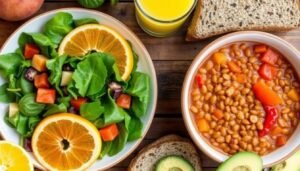What to Eat to Improve Anemia
When dealing with anemia, focusing on iron-rich foods can significantly help in boosting red blood cell production and improving overall health. Here are key iron sources and their benefits:
- Lean Meats (Heme Iron)
Lean meats like beef, chicken, and turkey are excellent sources of heme iron, the most easily absorbed form of iron. In addition to iron, these meats provide vitamin B12 and zinc, which further support red blood cell formation and energy. - Legumes (Non-Heme Iron)
For those on a plant-based diet, legumes such as lentils, chickpeas, and beans offer non-heme iron along with folate and fiber. These nutrients aid blood cell health and promote digestion. - Fortified Cereals and Whole Grains
Whole grains like quinoa, brown rice, and oats are rich in non-heme iron and can contribute to increasing your iron intake. Regularly consuming these foods can boost your body’s iron levels. - Dark Leafy Greens
Vegetables such as spinach, kale, and Swiss chard provide non-heme iron, antioxidants, and essential vitamins. These greens support red blood cell production and help reduce inflammation.
Including a range of these foods in your diet can enhance iron absorption and effectively manage anemia symptoms.
Foods to Avoid When You Have Anemia
Certain foods can hinder iron absorption or worsen anemia symptoms. Here’s what to avoid:
- High-Tannin Foods and Drinks
Beverages like tea and coffee are high in tannins, which inhibit the absorption of non-heme iron. Avoid consuming these close to meal times; instead, try to space them out by at least one hour before or after meals. - Calcium-Rich Foods
Calcium competes with iron for absorption, so avoid pairing calcium-rich foods (like dairy products) with iron-rich meals. It’s advisable to consume calcium and iron separately for optimal nutrient absorption. - Foods with Phytates (Phytic Acid)
Phytates, found in grains, legumes, nuts, and seeds, can bind to minerals like iron and reduce absorption. To minimize this effect, soak, sprout, or ferment these foods before eating.
By avoiding high-tannin drinks, separating calcium intake, and managing phytate levels, you can help your body better absorb iron and maintain optimal health.
What to Expect
Increasing your intake of iron-rich foods can bring noticeable health benefits:
- Increased Energy Levels
Anemia often causes fatigue and weakness. Consuming foods high in iron, such as lean meats and dark leafy greens, helps replenish iron stores and improves energy levels. - Enhanced Cognitive Function
Iron supports neurotransmitter production, crucial for cognitive processes. Studies suggest that iron deficiency can impair concentration, memory, and clarity. Foods like fortified cereals, nuts, and seeds aid in brain health and cognitive enhancement. - Improved Physical Symptoms
Anemia symptoms like pale skin, brittle nails, and shortness of breath often improve with increased red blood cell production. Prioritizing iron-rich foods (seafood, poultry, beans) can help alleviate these symptoms over time. Pairing iron with vitamin C-rich foods can further enhance absorption.

Preparing Food for Anemia
To optimize iron absorption, consider these food preparation tips:
- Cooking Methods
Use techniques that preserve nutrient content, such as steaming, stir-frying, and light sautéing. Avoid deep frying or high-heat cooking, which can lead to nutrient loss. - Combining Iron with Vitamin C
Pairing iron-rich foods with vitamin C sources (e.g., citrus fruits, strawberries, bell peppers) can enhance non-heme iron absorption. Adding lemon juice to a spinach salad or bell peppers to a bean stew improves iron uptake. - Timing with Calcium
Since calcium inhibits iron absorption, avoid pairing calcium-rich foods with iron-rich meals. Aim to separate calcium intake by a few hours for better nutrient bioavailability.
Meal Plans for People With Anemia
A balanced meal plan can help manage anemia effectively. Here’s how to structure meals:
- Include Heme Iron Sources
Lean meats, poultry, and seafood are rich in heme iron and should be prioritized for their high absorption rate. - Add Non-Heme Iron Foods
Incorporate plant-based iron sources like beans, lentils, tofu, nuts, seeds, whole grains, and dark leafy greens. Pair these with vitamin C-rich fruits and vegetables (like bell peppers or citrus) to enhance absorption.
More Anemia Diet Tips
Here are additional dietary tips to support iron absorption:
- Consume Vitamin C-Rich Foods Regularly
Vitamin C boosts the absorption of non-heme iron. Try adding oranges, strawberries, or kiwi to meals, or enjoy a glass of orange juice with iron-rich dishes. - Use Proper Cooking Techniques
To retain water-soluble vitamins (like vitamin C and B vitamins), steam or lightly sauté vegetables. Using cast-iron cookware can also add small amounts of iron to meals. - Diversify Your Diet
A varied diet with fruits, vegetables, whole grains, lean proteins, and healthy fats provides essential nutrients (e.g., folate, vitamin B12, zinc, and copper) that aid red blood cell production and energy metabolism.

Conclusion
Incorporating iron-rich foods can significantly improve anemia management. Focus on lean meats, fish, poultry, beans, lentils, and fortified cereals to boost iron intake and support red blood cell health. Pairing these foods with vitamin C enhances iron absorption. Avoid foods that hinder absorption, like those high in calcium or caffeine. With mindful dietary choices, you can manage anemia more effectively and work towards improving your health.
Small, consistent changes in nutrition can lead to noticeable improvements, allowing you to thrive while managing anemia. Embrace new, nourishing recipes, and take control of your health by making informed choices about what you eat.